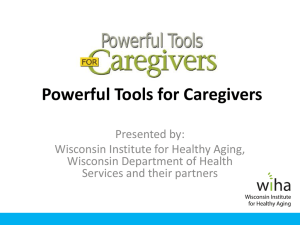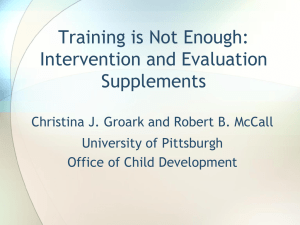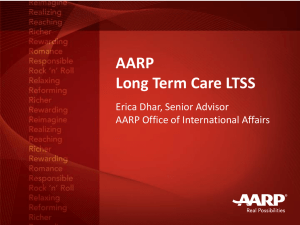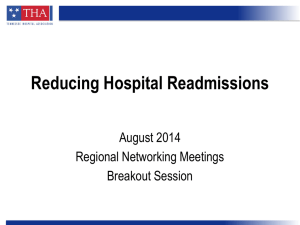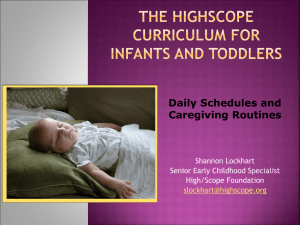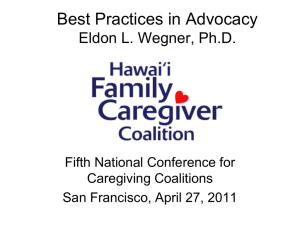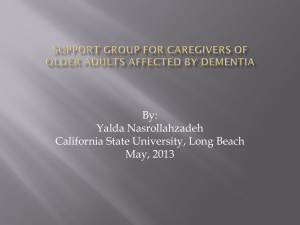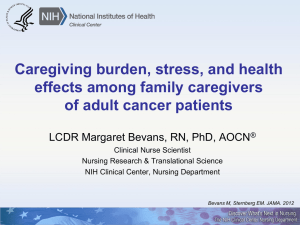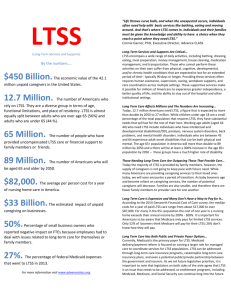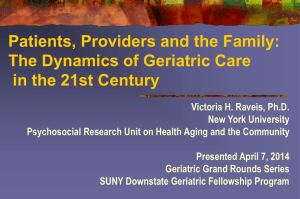Greg Olson`s PowerPoint Presentation
advertisement
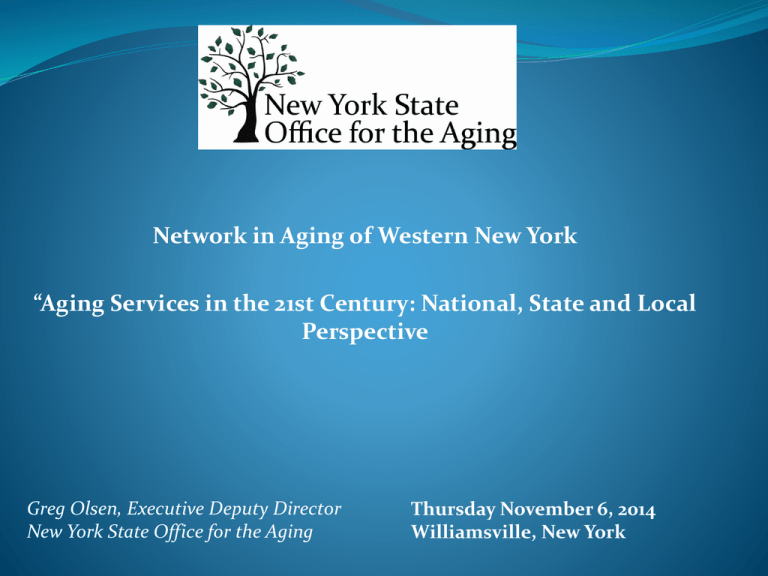
Network in Aging of Western New York “Aging Services in the 21st Century: National, State and Local Perspective Greg Olsen, Executive Deputy Director New York State Office for the Aging Thursday November 6, 2014 Williamsville, New York The PAST The Older Americans Act “Countervailing Force” to Medicare and Medicaid • Passed in 1965 • The primary federal discretionary funding source for home and community based services for older adults • The goal: keep older adults healthy and independent, and living in the community. • Established the Aging Services Network • Focused on multi-disciplinary partnerships at community level Adjusted/Amended 12 times, about once every 4 years Evolution of the role of the network over time The Past Older adults are a drain on resources Older adults not valuable Care and assistance focused primarily on clinical/skilled care Prevention not priority Direct Line – Hospital to NH instead of home first Social determinants of health not understood/incentivized/valued Role of caregivers not recognized Major issues preventable and manageable Chronic conditions Falls and injury related falls Results of “The Past” policies focused on paying for interventions that address medical needs, not social needs Payers had little incentive to cover social interventions that provide long term clinical and financial rewards Payments based on procedures/tests, visits and discharges – not clinical outcomes Community supports lacking Innovation stymied Silos created Accountability lacking Waste and fraud Prevention not priority High expenses, poor outcomes Quality of care poor The Present 3.7 million people 60+ - rank #3 nationally Very diverse group – physically, culturally, ethnically, economically, educationally, health status, etc. 1.8 million people age 75+ - fastest growing cohort in NYS 330,000 with Alzheimer’s Disease 700,000 individuals age 60+ contribute 119 million hours of service at economic value of $3.35 billion 64% of individuals age 60+ own their own homes, 64% have no mortgage 4.1 million caregivers at any time in a year – economic value if paid for at market rate is $32 billion, average age is 64 $90 Billion in lost productivity to businesses due to caregiving 6 The Present - Aggregate Income by Age - NYS Ages Aggregate Income Less than 24 $22,434,274,582 4.17% 25 to 44 $204,658,371,951 38.01% 45 to 64 $235,878,868,294 43.81% 65 and over $75,498,394,809 14.02% TOTAL % of Total $538,469,909,636 In addition to the billions in income generated from this age group, according to the AARP, persons over the age of 50 control half of the country's discretionary spending. Hold over $7 trillion in wealth Source - Current Population Survey, March Supplement, 2011. Erie and Niagara Counties Erie Niagara Total Population 2015 907,099 2025 884,405 2015 214,450 2025 211,625 0-17 18-44 45-59 60+ 45+ 189,803 308,485 196,268 212,543 408,811 (45%) 185,537 298,633 152,034 248,201 400,235 (45%) 44,638 67,923 49,297 52,592 101,889 (48%) 44,160 64,816 37,905 64,744 102,649 (49%) Own 75% No Mortgage 66% Own 77% No Mortgage 70% Home Ownership Volunteers # 60+ 37,548 Hours 2,627,804 Value $73,578512 # 60+ 2,462 Hours 172,315 Value $4,824,820 Erie and Niagara County - Economics Erie Niagara Social Security (annual) $2.9 trillion $742 million Personal Income Generated Total $24,917,804,500 $5,385,440,700 25-44 $7,672,822,000 $1,673,449,300 45-64 $12,213,372,800 $2,679,181,400 65+ $4,565,454,000 $962,465,200 45+ $16,778,826,800 (67%) $3,641,646,600 (68%) The Present Family Structure . . . United States Married couple families Married couple families with children Single parent households Single person households Non-traditional households County Data New York State 62 Counties Change in Population Aged 60 and Over 2010 to 2020 Proportion of County Population Aged 60 and Over Number of Counties with Specified percent of Older Persons 2010 2020 Less than 20% 33 4 20% to 24% 26 32 25% to 29% 1 22 30% and over 2 4 Source: Woods & Poole Economics, Inc., 2011 State Profile Demographic Change Foreign Immigration 100,000 each year come to NYS 1.4 million legal, permanent since 2000 2.4 million people not proficient in speaking English Race and Ethnic Diversity Growth in all categories Migration Young workforce New retirees Frail older adults Young people Minorities out of state out of state back to NY out of rural areas into suburban and rural areas What We Know - Social Factors Directly Impact Health Spending Income, access to food, educational status, housing, employment affect health and longevity. Research attributes as much as 40% of health outcomes to social and economic factors (University of Wisconsin Population Health Institute) Food insecurity and diabetes related admissions Living conditions and asthma Physical activity and obesity Health policy has focused on paying for interventions that address medical needs, not social needs Payers had little incentive to cover social interventions that provide long term clinical and financial rewards Payments based on procedures/tests, visits and discharges – not clinical outcomes Social Supports and Health Care Older Adults – largest consumers of health care 65+ population spends 2x more than 45-64 Spends 3-5x more than all adults under 65 Medical Care – controlled by insurers, doctors, hospitals, drug companies and skilled nursing facilities Social Supports – community and family assistance, good nutrition, exercise, transportation, safe housing, volunteering – not reimbursed Medical Community - have not traditionally seen the benefit in social supports and don’t understand their importance 14 Social Supports Older adults 80% have at least one chronic condition 50% have at least 2 Means more visits to health professionals, more medications, decline in overall wellbeing and quality of life Means limited mobility, social isolation and need for LTSS more common Health care cannot solve the problem Need Communities to plan for and accommodate, map assets and opportunities and design a new paradigm Livable/Age Friendly Communities - Erie 15 Other Costs Associated with Chronic Conditions • Cost of an individuals independence and quality of life?? • Costs for long-term care – exceed $500 billion nationally • Out of pocket costs for individuals – Co-pays, premiums, deductibles – Prescriptions, then run risk of adverse interactions – Spend-down – DME • Business costs – loss productivity and health spending • Economic costs – local and state economy, income, assets The Future Retain and attract boomers/retirees in our communities Economic Development: Gray Gold States court retirees as a "clean" growth industry– for every couple that leaves a state – 1.5 jobs associated with supporting an older couple. 25,000 retirees leave NYS annually – 12,000 come to NY = (-13,000) The "graying" of the U.S. population creates substantial opportunities for businesses that target their products and services at older consumers. Increasingly, economic development experts - regard affluent, mobile retirees as a key customer base with a stable stream of income to be spent on local purchases and investments. Just as states have competed in "smokestack chasing" for years, many have begun to focus on attracting and retaining retirees. http://www.window.state.tx.us/comptrol/fnotes/fn9611.html 18 What do We Really Want? To make our own decisions or, at least, be empowered to be active part of decisions about us To stay in our homes/communities To be as independent as possible To have choices To maintain relationships, have purpose To be able to assume personal risk, be in control To receive assistance as needed, on our terms and schedules Not be vilified for asking for and receiving help To access support services– transportation, snow removal, lawn mowing, home modifications, etc. To have help maneuvering various systems that are complex – i.e., bills, health plan/Medicare info, application assistance 19 What Services Meet that Goal Case management Home delivered meals (HDM) Congregate meals Nutrition counseling & education NY Connects (ADRC) - LTSS I&A/R, options counseling, benefits and application assistance Health Insurance Information , Counseling and Assistance (HIICAP) Personal Care Level I and II (non-Medicaid) Senior center programming Health promotion and wellness Evidence Based Interventions – CDSMEs, fall prevention, etc Volunteer opportunities Caregiver support services for those caring older adults, older adults caring for adult children with disabilities, grandparents raising grandchildren 20 What Services Meet That Goal? Respite Support groups Public education and outreach Information and Assistance, benefits application assistance Ancillary services such as PERS and assistive devices Social adult day services Transportation to needed medical appointments, community services and activities Employment – Title V Legal Services Home modifications, repairs Bill paying Long Term Care Ombudsman 21 Changes Are Occurring ACA covering more low income via Medicaid and middle income via subsidy New payment models holding providers accountable for patient health and treatment costs (i.e. capitated, global, bundled, shared savings, penalties for hospital readmissions, etc.) – social determinants CMMI – Innovations fund - $10 billion over 8 years to test innovative payment and service models Patient centered medical homes – must integrate social supports into their care models – triggers higher levels of reimbursement BIP – Balanced Incentive Payment Program – rebalance LTSS, break down silos Stronger business case to invest in social interventions 22 Changes Are Occurring - Federal and State Direction – Rebalance LTSS – Stay in Community Olmstead Plan Medicaid Redesign Team (MRT) Health Homes Fully Integrated Dual Advantage (FIDA) Managed Long Term Care (MLTC) Community First Choice Option (CFCO) Money Follows the Person (MFP) Center for Medicare and Medicaid Innovation (CMMI) Delivery System Reform Incentive Payment Program (DSRIP) Accountable Care Organizations, etc. Managed Long Term Care WHICH SERVICES ARE PROVIDED BY THE MLTC PLANS - Benefit Package of "Partially Capitated" Plans MLTC Benefit Package (Partial Capitation) (Plan must cover these services, if deemed medically necessary. Member must use providers within the plan's provider network for these services). Home Care, including: Adult Day Health Care (medical model and social adult day care) Personal Emergency Response System (PERS), Nutrition -- Home-delivered meals or congregate meals Home modifications Medical equipment such as wheelchairs, medical supplies such as incontinent pads, prostheses, orthotics, respiratory therapy Physical, speech, and occupational therapy outside the home Hearing Aids and Eyeglasses Four Medical Specialties: Personal Care (Home attendant or Housekeeping) Certified Home Health Agency Services (home health aide, visiting nurse, visiting physical or occupational therapist) Private Duty Nursing Consumer Directed Personal Assistance Program Podiatry Audiology + hearing aides and batteries Dental Optometry + eyeglasses Non-emergency medical transportation to doctor offices, clinics (ambulette) Nursing home care Balancing Incentive Program What Will a NWD Hub Do? NWD Hub will: Assist individuals of all ages and populations over the phone or in-person; Provide information about LTSS; Conduct NWD Screen as appropriate; Coordinate and share information with Specialized NWD through secure database as needed; Coordinate applications for public benefits and other services; and Provide information to Specialized NWDs for comprehensive assessments and care planning. 12 How to Access the NWD Hub? Any individual will be able to access the NWD Hub by: NY Connects website, 1-800 Number, or In-person. The NY Connects website will have an expanded resource directory where an individual can search for services by county without assistance. NY Connects website will also have an optional online questionnaire which will help determine what services an individual may need. 13 DSRIP Medicaid Waiver designed to reinvest $6.4 billion for the purpose of promoting multi-systems community collaborations that achieve the goal of 25% reduction in avoidable hospital use over 5 years. Includes health care, behavioral health and social services public private partnerships. PPS – Performing Provider Systems Are required to engage all relevant stakeholders Required to develop an integrated delivery systems May implement 5-7 projects each in appropriate domains Can apply to become Accountable Care Organizations May apply for regulatory relief (waivers of regs) DSRIP DSRIP Projects All projects must be derived based on a Community Needs Assessment (CAN) A comprehensive assessment of health care resources and community based resources currently available in the service area and the demographics and health needs of the population to be served Identifies gaps Identifies excesses Community Resources Supporting PPS Approach – includes Community outreach agencies Transportation services NFP health and welfare agencies Self-advocacy and family support agencies Community service agencies Local government social service programs Family support and training Caregiving The National Caregivers Library (http://www.caregiverslibrary.org/Portals/0/Business_Caregiving_Bottom_LineJune2009NATIONAL.pdf ) estimates that the costs exceed $90 billion because the MetLife study only included caregiving for individuals age 60 and older. Recruitment, Retention and Training At any given time, more than 20% of the workforce is dealing with a caregiving situation. 33% of caregivers decrease the number of hours they work 29% quit their job or retire early 22% take a leave of absence 20% change their job status or go part-time Lost Productivity 53% of caregivers admit that their job performance is negatively affected 84% make caregiving related phone calls during business hours 68% arrive late or leave early 67% take time off from work during the day Increased Healthcare Cost Even when your employees are caring for someone not covered by your health plan, the employers healthcare cost can go up. 75% of working caregivers report an adverse affect on their own health 50% report 8 additional visits per year to a health care provider (for themselves) as a result of their caregiving responsibilities 22% report a significant impact on their own health (Statistics taken from National Caregivers Library) JAMA – March 12, 2014 – Caregiver Burden Clinical Review Highlights the despair that family and friends (caregivers) can feel when supporting frail or disabled relatives and the failure of the US Healthcare system to recognize and support them. Highlights need for support due to advanced age and change drivers Health care has not adapted to the needs of Aging Americans Unpaid and untrained caregivers must handle medical devices, medications and treatments that were once restricted to clinicians. Family caregivers provide most of the hands-on-care – often for years without a break, without pay, without a vacation, without recognition, without backup, without help. The result – widespread and unnecessary suffering, isolation, fear, error, and at times, bankruptcy, affecting the care receiver and the family Did You Know The Network of Aging Service Providers Served almost 600,000 people last year Served over 13,000 Medicaid clients (duals) Served more than 7,200 older adults with a diagnosed mental health condition Served more than 3,000 older adults with alcohol/substance abuse problem All AAA’s now screen for alcohol/drug use and misuse (CAGE) Many screen for depression (PHQ9) and anxiety (GAD7) Dementia screen will be rolled out in 2014 Caregiver screen rolled out in 2014/2015 The Future - What We Need To Do Recognize the social, intellectual and economic capital of older adults - -plan for it and put it to use Better integrate social supports with medical care Take seriously the role of caregivers – screen and support Develop new and innovative financing models not solely based on health interventions Finance social supports Finance offices for the aging Community Planning – aging in place Livable NY Age Friendly neighborhoods 33 How to Fund Social Supports 1. Non-profit hospitals are required to provide a community health benefit usually equal to the value of their tax exempt status – estimated at $13 billion annually (GAO) Since much of this money was spent on care for the poor, and given that ACA is covering man of these individuals now– might be able to shift funds to social supports 2. ACA requires tax-exempt hospitals to conduct a community needs health assessment and develop an implementation strategy for addressing the needs once every 3 years o US Center for Disease Control and Prevention recommended that the assessment include information on social determinants of health o IRS requires (Schedule H-990) tax-exempt hospitals to report spending on activities benefitting the community. 34 How to Fund Social Supports Offices for the Aging and other human/social service agencies can and are contracting with: managed care Managed long term care Accountable Care Organizations Health Homes VA Hospitals – care transitions Health systems for EBI’s Could be for: Medicare (FIDA) DSRIP (delivery system reform incentive payment) Commercial Insurance Businesses Relationship building and trust – demonstrate value 35 How do We Increase Service Capacity – Non-Medicaid/PreMedicaid? o Current Tools o Long term care insurance/ Partnership o Reverse mortgages o Savings o Trusts and other legal tools New Financing Mechanisms for Network Independence Savings Accounts/Family Accounts Independence Insurance Independence Credit – Tapping Home Equity for network services Private Pay Development Cost Sharing for OAA Cost-Sharing & Private Pay NYSOFA is exploring cost-sharing for OAA programs as well as state funded programs Model could be similar to EISEP Target is middle income older adults/family members/caregivers Additional revenue generated folded back into programs to expand services and reduce waiting lists Nutrition programs not allowable under federal costsharing but could be allowable using state and local funding Looking at developing policies, protocols and standards in 2015 Would like it to be optional for counties Cost-Sharing & Private Pay NYSOFA is developing policies, procedures and protocols on developing private pay models in NYS Large number of middle income older adults, families and caregivers Limited state/federal funding Current waiting lists Demand will increase with implementation of BIP and SFY2014-15 language directing all health care practitioners in NYS to provide NY Connects phone number if they believe their patients would benefit from LTSS Goal is to ensure some standardization of how private pay models work Protect individuals Value Reduce exploitation/scams Summary Older adults are valuable – economically, intellectually and socially – tap them Care models must move away from strictly medical models – they don’t work Financing models must include social supports and non-medical LTSS New Financing models must be developed to focus on types of services offered by OFA’s Communities are in best position to plan for and develop livable and healthy communities for all ages 39 Thank you
